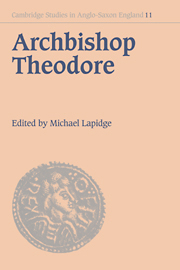Book contents
- Frontmatter
- Contents
- Preface
- List of abbreviations
- 1 The career of Archbishop Theodore
- 2 The Syriac background
- 3 Theodore of Tarsus and the Greek culture of his time
- 4 Rome in the seventh century
- 5 Theodore, the English church and the monothelete controversy
- 6 The importation of Mediterranean manuscripts into Theodore's England
- 7 Theodore and the Latin canon law
- 8 The Penitential of Theodore and the Iudicia Theodori
- 9 Theodore and the Passio S. Anastasii
- 10 Theodore and the Laterculus Malalianus
- 11 Theodore and the liturgy
- 12 Theodore's Bible: the Pentateuch
- 13 Theodore's Bible: the gospels
- 14 Theodore and Anglo-Latin octosyllabic verse
- 15 The Canterbury Bible glosses: facts and problems
- Index
2 - The Syriac background
Published online by Cambridge University Press: 03 May 2010
- Frontmatter
- Contents
- Preface
- List of abbreviations
- 1 The career of Archbishop Theodore
- 2 The Syriac background
- 3 Theodore of Tarsus and the Greek culture of his time
- 4 Rome in the seventh century
- 5 Theodore, the English church and the monothelete controversy
- 6 The importation of Mediterranean manuscripts into Theodore's England
- 7 Theodore and the Latin canon law
- 8 The Penitential of Theodore and the Iudicia Theodori
- 9 Theodore and the Passio S. Anastasii
- 10 Theodore and the Laterculus Malalianus
- 11 Theodore and the liturgy
- 12 Theodore's Bible: the Pentateuch
- 13 Theodore's Bible: the gospels
- 14 Theodore and Anglo-Latin octosyllabic verse
- 15 The Canterbury Bible glosses: facts and problems
- Index
Summary
The history of Christianity in late antiquity is all too often based on a bifocal model, consisting of the Greek East and Latin West. Tertium non datur – at least from a Chalcedonian viewpoint. Though for the most part separated ecclesiastically from the Greek and Latin churches as a result of the christological controversies of the fifth century, and politically from the Byzantine empire as a result of the Arab invasions in the third decade of the seventh century, the Syriac Orient in this latter century was still very much part of the cultural world of Graeco-Roman civilization, and indeed the Syriac Orient should be seen as a co-heir, along with the Latin West, of the Greek East: large numbers of Greek texts, both religious and secular, were translated into Syriac as well as into Latin, and in many cases the same texts were selected, often employing the same sorts of translation techniques. In the case of Syriac, the choice of Greek theological texts to be translated was governed in part by the theological colour of the ecclesiastical community concerned. Here there are three groupings:
(1) the Syrian Orthodox (opprobriously nicknamed Jacobites' after the sixth-century bishop, Jacob Baradaeus, or ‘Monophysites’), who rejected the Council of Chalcedon (AD 451), and saw themselves as the true heirs of Cyril of Alexandria's christological teaching, as expounded by Severus of Antioch (d. 538);
(2) the Church of the East (opprobriously called ‘Nestorians’ by their opponents), who rejected the Council of Ephesus (AD 431) and regarded Theodore of Mopsuestia as their guide in matters both theological and exegetical;
[…]
- Type
- Chapter
- Information
- Archbishop TheodoreCommemorative Studies on his Life and Influence, pp. 30 - 53Publisher: Cambridge University PressPrint publication year: 1995
- 6
- Cited by

